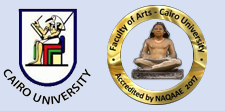عنوان المقال عربي
الإيقاع وعلاقته بالصراع فى المسرح الشعرى نماذج متنوعة
Document Type
Book Review
Abstract English
This paper attempted to examine the relations among rhythm, conflict and dialogue in poetic play (verse drama). It based on a hypothesis that rhythm can play a major role in the conflict emerging between the characters of the Poetic play and can highlight the hidden meanings and connotations of dialogue, on other hand; it tends to add new dimensions to conflict. To testify this hypothesis we chose a number of scenes from poetic plays representing different theatrical and Poetic schools; the basis of choice of these scenes, on the one hand, was the intensification of the conflict - whatever its kind- on the other hand, the intuition of the role of rhythm as one of the most important aspects of the text structure of a poetic play. The paper chose to focus its discussion on the quantitative element of rhythm, because it is the most prominent rhythmic element in a poetic play, in the first place, and investigating the qualitative elements - which did not be neglected totally in this paper- needs more space and a comprehensive view beyond the scope here. The paper presented a number of examples that reveal the extent to which the rhythm can play a significant role in the poetic play. It concluded that rhythm can highlight a conflict in the theatrical work, add a number of meanings and connotations, show audience the feelings and emotions in auditory form and do many other roles. This issue still to be a fertile soil needs more research interest.
الملخص العربي
يسعى هذا البحث إلى دراسة العلاقة بين الإيقاع والصراع والحوار في المسرحية الشعرية. تقوم الفرضية الأساسية لهذا البحث على أن الإيقاع يمكنه أن يلعب دورا كبيرا في الصراع الناشئ بين أطراف المسرحية الشعرية.. يستطيع أن يبرز دلالات ربما كانت خفية للحوار المسرحي، ويضيف أبعادا جديدة لهذا الصراع. ولاختبار هذه الفرضية اخترنا عددا من المشاهد من مسرحيات شعرية تمثل مدارس مسرحية وشعرية مختلفة، وكان أساس اختيارنا لهذه المشاهد احتدام الصراع –أيا كان نوعه- فيها من جهة، وإحساسنا بدور الإيقاع فيها من جهة أخرى، باعتباره واحدا من أهم العناصر الفاعلة في بنية النص. واخترت أن أركز حديثي على العنصر الكمي في الإيقاع، لأنه العنصر الأبرز أولا، ولأن الحديث عن العناصر الكيفية -التي لم نتناسها كليا في دراستنا هذه- يحتاج مساحة أكبر وسردا مطولا. وقد قدمت عددا من الأمثلة التي تكشف لأي مدى يمكن أن يلعب الإيقاع دورا كبيرا في المسرحية الشعرية؛ حيث يبرز –أولا- الصراع -أيا كان نوعه- داخل العمل المسرحي.. ويستطيع -ثانيا- أن يضيف عددا من الدلالات، وأن يلقي -ثالثا- الضوء على دلالات أخرى. ويستطيع -رابعا- أن يقدم لك المشاعر والأحاسيس في صورة سمعية يشعر بها من كانت عنده القدرة على التقاطها... أدوار كثيرة يمكن أن يقوم بها الإيقاع، علينا أن نحاول اكتشافها والسعي وراءها، وما ذكرناه هنا إلا النذر اليسير منها.
Recommended Citation
Ammar, Ahmed
(2018)
"Rhythm and its relationship to conflict in poetic theater are various models,"
Journal of the Faculty of Arts (JFA): Vol. 78:
Iss.
3, Article 3.
DOI: 10.21608/jarts.2018.83453
Available at:
https://jfa.cu.edu.eg/journal/vol78/iss3/3
Digital Object Identifier (DOI)
10.21608/jarts.2018.83453
Accept Date
2017-04-18
Publication Date
7-1-2018

